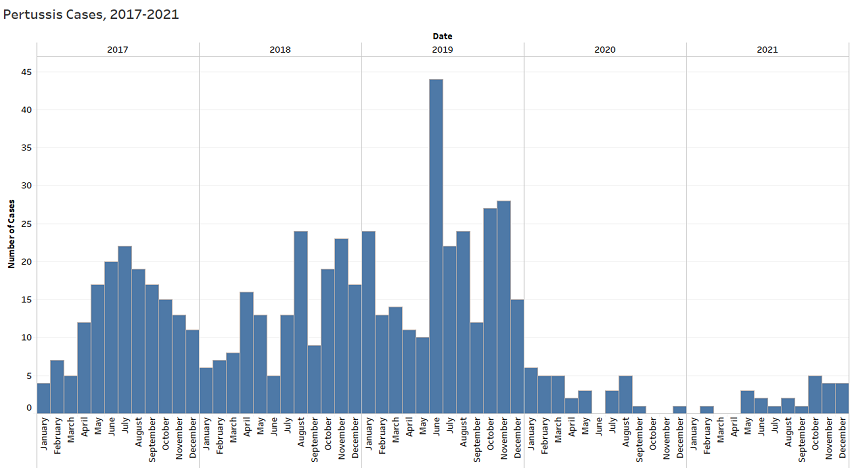Pertussis
Definition
Pertussis is a disease caused by a bacteria which causes severe spells of coughing. These spells can interfere with eating, drinking, and breathing. Pertussis can lead to pneumonia, convulsions, inflammation of the brain (encephalitis) and sometimes death. It is most common in infants less than one year old, but anyone can get it. It is also known as whopping cough because of the high-pitched whooping sound made when breathing in during coughing spells.
Pertussis is reportable to the Iowa Department of Public Health by Iowa Administrative Code 641 Chapter 1.
Symptoms
On average, it will take 9-10 days after being infected with pertussis to start to show signs and symptoms. At first, symptoms will look a lot like the common cold:
- Runny nose
- Nasal congestion
- Sneezing
- Red, watery eyes
- A mild fever
- Dry cough
Within two weeks, symptoms worsen and a severe cough develops that might:
- Become a series of violent coughs making it hard to breathe
- Be more severe at night
- Expel thick phlegm
- Cause vomiting
- End with a high-pitched "whoop" sound when breathing in after a series of coughs
However, infants under 6 months old may not develop a whoop but may temporarily stop breathing or have a bluish tint to their skin. Older children and adults also may not develop a whoop but will have a long lasting cough, or have symptoms like bronchitis or asthma. Vaccinated people might also have milder symptoms.
Causes
Pertussis is caused by breathing in a bacteria carried on droplets from other’s coughs and sneezes.
Once inhaled into the lungs, the bacteria grows and produces a toxin that keeps your lungs from moving fluids and germs out. Thick mucus accumulates inside the airways and results in an uncontrollable cough.
The “whoop” sound is caused by the sucking in of air through the restricted airways after a coughing fit.
Risk Factors
Though a vaccine is available against pertussis, protection wears off 5-10 years after the last dose leaving most teenagers and adults not fully protected. Also, a person is not fully immune until after three doses of a pertussis vaccine.
Prevention
- There are four combination vaccines used to prevent diphtheria, tetanus and pertussis: DTaP, Tdap, DT, and Td. Two of these (DTaP and DT) are given to children younger than 7 years of age, and two (Tdap and Td) are given to older children and adults. Several other combination vaccines contain DTaP along with other childhood vaccines. Children should get 5 doses of DTaP, one dose at each of the following ages: 2, 4, 6, and 15-18 months and 4-6 years. DT does not contain pertussis, and is used as a substitute for DTaP for children who cannot tolerate pertussis vaccine. Td is a tetanus-diphtheria vaccine given to adolescents and adults as a booster shot every 10 years, or after an exposure to tetanus under some circumstances. Tdap is similar to Td but also containing protection against pertussis. Adolescents 11-18 years of age (preferably at age 11-12 years) and adults 19 through 64 years of age should receive a single dose of Tdap. For adults 65 and older who have close contact with an infant and have not previously received Tdap, one dose should be received. Tdap should also be given to 7-10 year olds who are not fully immunized against pertussis. Tdap can be given no matter when Td was last received. [Upper-case letters in these abbreviations denote full-strength doses of diphtheria (D) and tetanus (T) toxoids and pertussis (P) vaccine. Lower-case “d” and “p” denote reduced doses of diphtheria and pertussis used in the adolescent/adult-formulations. The “a” in DTaP and Tdap stands for “acellular,” meaning that the pertussis component contains only a part of the pertussis organism.]
- Handwashing is important for preventing all illness including pertussis
- Cover your mouth and nose when you cough or sneeze
- Avoid others when coughing
- In general, you should stay home when you are sick. If you are diagnosed with pertussis or are a contact to a known case of pertussis and have symptoms, you should stay home for 21 days or until you have completed 5 full days of antibiotics
Treatment
- An appropriate antibiotic can be taken if given early in illness
- Fluids, oxygen, and mild sedation may help a child during prolonged periods of severe coughing
- Always consult your health care provider if you have questions about your health or before starting any treatment
Statistics
In 2021, there were 23 cases of pertussis reported to IDPH.
For more detailed information and statistics on all notifiable diseases, please see our current annual report located in the reports section of the CADE homepage.

Additional Resources
Public
Public Health
Schools
Business and Child Care
Health Care Providers
Pertussis Letter Templates